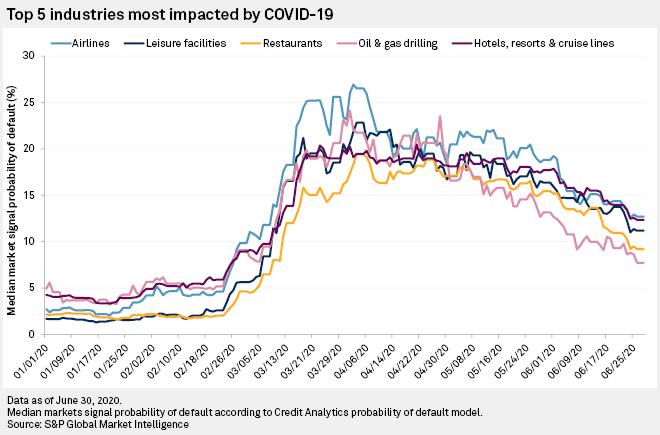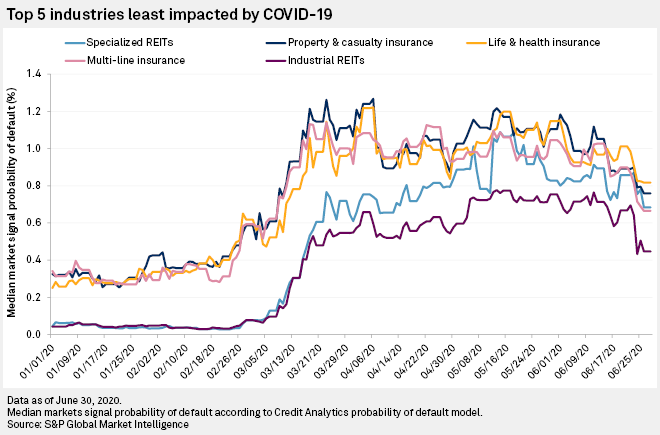The threat of defaults that had spiked during the peak of the pandemic panic is diminishing, with the risk associated with the sectors most affected by the pandemic more than halving from the early-April peak.
The probability-of-default, or PD, model, devised by the Credit Analytics branch of S&P Global Market Intelligence, calculates a median one-year market signal probability of default for 64,000 public companies across the world. The figure represents the odds that a company will default on its debt within the next year based on fluctuations in the company's share price and other country- and industry-related risks.
The tourism industry, effectively suspended by mass lockdowns and travel restrictions, dominated the list of worst-hit sectors. But as policymakers have stepped up support and rules that hamstrung the economy have relaxed, the median market signal for probability of defaults has eased.
The PD score of airlines, deemed the most vulnerable sector by the model, has fallen to 12.7% as of June 28, down from a peak of 26.9% on April 2.
 |
Similarly, the PD score of restaurants has fallen from 19.4% on April 3 to 9.2% as companies have been able to open their doors to hungry customers, while hotels are experiencing a shallower recovery with the PD score down to 12.3% from the 20.4% peak on March 23.
The improvement reflects the strength in equities, particularly in the U.S. The 21% rally in the S&P 500 in the second quarter was the strongest quarterly gain since 1998, while there were smaller gains in other global benchmark indices such as the FTSE 100 in the U.K., which gained 8.8%.
"A higher appetite for risk saw investors bid up shares in many companies with considerable uncertainty over their current earnings strength, including engineer Rolls-Royce Holdings PLC, British Airways owner International Consolidated Airlines Group SA and media group WPP PLC," said Russ Mould, investment director at AJ Bell, in an email.
The oil and gas sector in particular has seen its probability of default reduce. Having peaked at 24.1% on April 1, and spiking above 21% again in late-April as the WTI oil futures contract went negative for the first time, the PD model suggests the risk had fallen sharply to 7.7% by June 28.
At the other end of the scale, a number of insurance and real estate investment trusts are the safest sectors according to the PD Model.
 |
Industrial REITs have enjoyed the lowest PD score all year with the sector benefiting from owning warehouses that are critical to the supply chains of companies like Amazon. Credit Analytics raised the risk of default in the sector from zero percent pre-pandemic to a peak of 0.78% on May 13. The risk was down to 0.45% as of June 28.
Different REITs and insurance sectors combined for six of the 10 least likely to default as of June 28.



